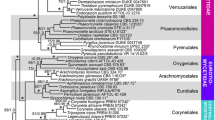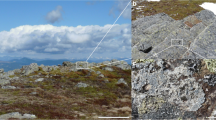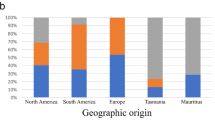Abstract
Lichenicolous fungi belonging to the anamorph-typified genus Phaeosporobolus and to the teleomorph-typified genus Lichenostigma were isolated in pure culture or sequenced directly, with nuLSU and mtSSU sequences obtained. Phylogenetic analyses place the species of Phaeosporobolus in a strongly supported clade with the generic type of Lichenostigma (L. maureri), the genus Phaeococcomyces and several melanized rock-inhabiting isolates. This strongly supported nonlichenized lineage is sister to the primarily lichenized Arthoniales in the Arthoniomycetes and is here described as the Lichenostigmatales. The new order is characterized by cells multiplying by budding, either representing black yeasts, or species in which conidiomata and ascomata are entirely made of an organised agglomeration of spherical yeast-like cells. This way of life is not only very different from all other Arthoniomycetes that exist only in the mycelial stage, but ascomata and conidiomata representing a dense and organised agglomeration of yeast cells might be unique amongst fungi. A further difference with the Arthoniales is the absence of paraphysoids. Phylogenetic results suggest that Phaeosporobolus usneae is the asexual stage of Lichenostigma maureri. Most species of Phaeosporobolus are transferred to the genus Lichenostigma except P. trypethelii, for which the new genus Etayoa is described. The genus Diederimyces is reduced into synonymy with Lichenostigma. Several other members of Lichenostigma are placed in the Dothideomycetes and are intermixed with Lichenothelia species.







Similar content being viewed by others
References
Alstrup V, Hawksworth DL (1990) The lichenicolous fungi of Greenland. Medd Grønland Biosci 31:1–90
Baral HO (1987) Lugol’s solution/IKI versus Melzer’s reagent: hemiamyloidity, a universal feature of the ascus wall. Mycotaxon 29:399–450
Berger F, Brackel W (2011) Eine weitere Art von Phaeosporobolus auf Lecanora chlarotera. Herzogia 24:351–356
Brackel W (2011) Lichenicolous fungi and lichens from Puglia and Basilicata (southern Italy). Herzogia 24:65–101
Calatayud V, Barreno E (2003) A new Lichenostigma on vagrant Aspicilia species. Lichenologist 35(4):279–285
Calatayud V, Hafellner J, Navarro-Rosinés P (2004) Lichenostigma. In: Nash TH III, Ryan BD, Diederich P, Gries C, Bungartz F (eds) Lichen flora of the Greater Sonoran Desert Region, vol 2, Lichens Unlimited. Arizona State University, Tempe, pp 664–669
Calatayud V, Navarro-Rosinés P, Hafellner J (2002) A synopsis of Lichenostigma subgen. Lichenogramma (Arthoniales), with a key to the species. Mycol Res 106:1230–1242
Common RS (1991) The distribution and taxonomic significance of lichenan and isolichenan in the Parmeliaceae. I. Introduction and methods. II. The genus Alectoria and associated taxa. Mycotaxon 41:67–112
Crous PW, Groenewald JZ, Shivas RG (2012) Phaeococcomyces eucalypti. Fungal Planet 113. Persoonia 29:158–159
Cunningham CW, Zhu H, Hillis DM (1998) Best-fit maximum likelihood models for phylogenetic inference: empirical tests with known phylogenies. Evolution 52:978–987
de Hoog GS (1979) Nomenclature notes on some black yeast-like hyphomycetes. Taxon 28:347–348
Diederich P (2004) Phaeosporobolus. In: Nash TH III, Ryan BD, Diederich P, Gries C, Bungartz F (eds) Lichen flora of the Greater Sonoran Desert Region. Lichens Unlimited, vol 2. Arizona State University, Tempe, pp 681–682
Diederich P, Ertz D, Eichler M, Cezanne R, van den Boom P, Fischer E, Killmann D, Van den Broeck D, Sérusiaux E (2012a) New or interesting lichens and lichenicolous fungi from Belgium, Luxembourg and northern France. XIV. Bull Soc Nat Lux 113:95–115
Diederich P, Lawrey JD, Sikaroodi M, van den Boom P, Ertz D (2012b) Briancoppinsia, a new coelomycetous genus of Arthoniaceae (Arthoniales) for the lichenicolous Phoma cytospora, with a key to this and similar taxa. Fungal Divers 52:1–12
Egea JM, Torrente P, Manrique E (1993) The Lecanactis grumulosa group (Opegraphaceae) in the Mediterranean region. Plant Syst Evol 187:103–114
Eriksson O, Hawksworth DL (1986) Notes on ascomycete systematics. Nos 1–224. Syst Ascomycetum 5:113–174
Ertz D, Bungartz F, Diederich P, Tibell L (2011) Molecular and morphological data place Blarneya in Tylophoron (Arthoniaceae). Lichenologist 43:345–356
Ertz D, Tehler A (2011) The phylogeny of Arthoniales (Pezizomycotina) inferred from nucLSU and RPB2 sequences. Fungal Divers 49:47–71
Etayo J (1995) Two new species of lichenicolous fungi from the Pyrenees. Nova Hedwig 61:189–197
Etayo J, Sancho LG (2008) Hongos liquenícolas del Sur de Sudamérica, especialmente de Isla Navarino (Chile). Bibl Lichen 98:1–302
Fernández-Brime S, Llimona X, Navarro-Rosinés P (2010) Lichenostigma rupicolae (Lichenotheliaceae), a new lichenicolous species growing on Pertusaria rupicola. Lichenologist 42:241–247
Flakus A, Kukwa M (2012) New species of lichenicolous fungi from Bolivia. Lichenologist 44:469–477
Gueidan C, Ruibal CV, de Hoog GS, Gorbushina AA, Untereiner WA, Lutzoni F (2008) A rock-inhabiting ancestor for mutualistic and pathogen-rich fungal lineages. Stud Mycol 61:111–119
Hafellner J (1982) Studien über lichenicole Pilze und Flechten II Lichenostigma maureri gen. et spec. nov., ein in den Ostalpen häufiger lichenicoler Pilz (Ascomycetes, Arthoniales). Herzogia 6:299–308
Hafellner J, Calatayud V (1999) Lichenostigma cosmopolites, a common lichenicolous fungus on Xanthoparmelia species. Mycotaxon 72:107–114
Harris RC, Lendemer JC (2009) The Fellhanera silicis group in eastern North America. Opuscula Philolichenum 6:157–174
Hawksworth DL, Hafellner J (1986) Phaeosporobolus usneae, a new and widespread lichenicolous deuteromycete. Nova Hedwig 43:525–530
Henssen A (1987) Lichenothelia, a genus of microfungi on rocks. In: Peveling E (ed) Progress and problems in lichenology in the eighties. Bibl Lichen 25. J Cramer, Berlin-Stuttgart, pp 257–293
Huelsenbeck JP, Ronquist F (2001) MRBAYES: bayesian inference of phylogeny. Bioinformatics 17:754–755
Ihlen PG (2004) A new species of Lichenostigma (Lichenotheliaceae, Arthoniales) from Scandinavia. Lichenologist 36:183–189
Kalb K, Hafellner J, Staiger B (1995) Haematomma-Studien, II. Lichenicole Pilze auf Arten der Flechtengattung Haematomma. Bibl Lichen 59:1–222
Knudsen K, Kocourkova J (2010) A new Lichenostigma species (genus incertae sedis) from southern California. Bryologist 113:229–234
Kocourková J (2000) Lichenicolous fungi of the Czech Republic (the first commented checklist). Acta Mus Natl Pragae Ser B Hist Nat 55:59–169
Lawrey JD, Diederich P (2003) Lichenicolous fungi: interactions, evolution, and biodiversity. Bryologist 106:80–120
Lawrey JD, Binder M, Diederich P, Molina MC, Sikaroodi M, Ertz D (2007) Phylogenetic diversity of lichen-associated homobasidiomycetes. Mol Phylogenet Evol 44:778–789
Lawrey JD, Diederich P, Nelsen MP, Sikaroodi M, Gillevet PM, Brand AM, van den Boom P (2011) The obligately lichenicolous genus Lichenoconium represents a novel lineage in the Dothideomycetes. Fungal Biology 115:176–187
Lawrey JD, Diederich P, Nelsen MP, Freebury C, Van den Broeck D, Sikaroodi M, Ertz D (2012) Phylogenetic placement of lichenicolous Phoma species in the Phaeosphaeriaceae (Pleosporales, Dothideomycetes). Fungal Divers 55:195–213
Liò P, Goldman N (1998) Models of molecular evolution and phylogeny. Genome Res 8:1233–1244
Lumbsch HT, Huhndorf AM (2010) Myconet Volume 14. Part One. Outline of Ascomycota–2009. Part Two. Notes on ascomycete systematics. Nos. 4751–5113. Fieldiana 1:1–64
Maddison D, Maddison W (2002) MacClade version 4.03PPC: analysis of phylogeny and character evolution. Sinauer, Sunderland
Mason-Gamer RJ, Kellogg EA (1996) Testing for phylogenetic conflict among molecular datasets in the tribe Triticeae (Gramineae). Systematic Biol 45:524–545
McGinnis MR, Schell WA, Carson J (1985) Phaeoannellomyces and the Phaeococcomycetaceae, new dematiaceous blastomycete taxa. Sabouraudia 23:179–188
Miadlikowska J, McCune B, Lutzoni F (2002) Pseudocyphellaria perpetua, a new lichen from Western North America. Bryologist 105:1–10
Miller MA, Pfeiffer W, Schwartz T (2010) Creating the CIPRES Science Gateway for inference of large phylogenetic trees. In: Proceedings of the Gateway Computing Environments Workshop (GCE), 14 Nov. 2010, New Orleans, LA, pp 1–8
Muggia L, Gueidan C, Knudsen K, Perlmutter G, Grube M (2012) The lichen connections of Black fungi. Mycopathologia. doi:10.1007/s11046-012-9598-8
Navarro-Rosinés P, Hafellner J (1996) Lichenostigma elongata spec. nov. (Dothideales), a lichenicolous ascomycete on Lobothallia and Aspicilia species. Mycotaxon 57:211–225
Posada D, Crandall KA (1998) MODELTEST: testing the model of DNA substitution. Bioinformatics 14:817–818
Rambaut A, Drummond AJ (2007) Tracer v1.5., available from: http://beast.bio.ed.ac.uk/Tracer
Rambaut A (2012) FigTree v1.3.1, available from: http://tree.bio.ed.ac.uk/software/figtree/
Rich MA, Stern AM (1958) Studies of Cryptococcus nigricans n. sp. I. Identification and taxonomic classification. Mycopathol Mycol Appl 9(3):189–193
Ronquist F, Huelsenbeck JP (2003) MRBAYES 3: bayesian phylogenetic inference under mixed models. Bioinformatics 19:1572–1574
Ruibal C, Platas G, Bills GF (2008) High diversity and morphological convergence among melanised fungi from rock formations in the Central Mountain System of Spain. Persoonia 21:93–110
Ruibal C, Gueidan C, Selbmann L, Gorbushina AA, Crous PW, Groenewald JZ, Muggia L, Grube M, Isola D, Schoch CL, Staley JT, Lutzoni F, de Hoog GS (2009) Phylogeny of rock-inhabiting fungi related to Dothideomycetes. Stud Mycol 64:123–133
Ruibal C, Millanes AM, Hawksworth DL (2011) Molecular phylogenetic studies on the lichenicolous Xanthoriicola physciae reveal Antarctic rock-inhabiting fungi and Piedraia species among closest relatives in the Teratosphaeriaceae. IMA Fungus 2:97–103
Stamatakis A, Ludwig T, Meier H (2005) RAxML-III: a fast program for maximum likelihood-based inference of large 437 phylogenetic trees. Bioinformatics 21:456–463
Stamatakis A (2006) RAxML-VI-HPC: Maximum Likelihood-based phylogenetic analyses with thousands of taxa and mixed models. Bioinformatics 22:2688–2690
Swofford DL (2002) PAUP*: phylogenetic analysis using parsimony (*and other methods). Version 4. Sinauer Associates, Sunderland
Thor G (1985) A new species of Lichenostigma, a lichenicolous ascomycete. Lichenologist 17:269–272
Tsuneda A, Hambleton S, Currah RS (2011) The anamorph genus Knufia and its phylogenetically allied species in Coniosporium, Sarcinomyces, and Phaeococcomyces. Botany 89:523–536
Valadbeigi T, Brackel W (2011) Two new species of Lichenostigma (Lichenotheliaceae, lichenicolous fungi) from Iran. Willdenowia 41:191–195
Vilgalys R, Hester M (1990) Rapid genetic identification and mapping of enzymatically amplified ribosomal DNA from several Cryptococcus species. J Bacteriol 172:4238–4246
von Arx JA (1963) Die Gattungen der Myriangiales. Persoonia 2:421–475
Yang Z, Goldman N, Friday A (1994) Comparison of models for nucleotide substitution used in maximum-likelihood phylogenetic estimation. Mol Biol Evol 11:316–324
Yoshimura I, Yamamoto Y, Nakano T, Finnie J (2002) Isolation and culture of lichen photobionts and mycobionts. In: Kranner I, Beckett RP, Varma A (eds) Protocols in lichenology – culturing, biochemistry, physiology and use in biomonitoring. Springer, Berlin, pp 3–33
Zoller S, Scheidegger C, Sperisen C (1999) PCR primers for the amplification of mitochondrial small subunit ribosomal DNA of lichen-forming ascomycetes. Lichenologist 31:511–516
Zwickl DJ (2006) Genetic algorithm approaches for the phylogenetic analysis of large biological sequence datasets under the maximum likelihood criterion. Ph. D. dissertation, The University of Texas at Austin.
Acknowledgments
We would like to thank the curators of herbaria cited in Materials and Methods for the loan of specimens. Ann Bogaerts, Myriam Dehaan and Wim Baert are thanked for technical assistance. Gisèle Van Cappellen, Trevor Goward, Nibedita Mukherjee and Paul Neuberg kindly provided fresh specimens used in this study. Finally, the first author acknowledges financial support from the Fonds National de la Recherche Scientifique (FNRS) from Belgium (F.R.F.C. # 2.4567.08).
Author information
Authors and Affiliations
Corresponding author
Rights and permissions
About this article
Cite this article
Ertz, D., Lawrey, J.D., Common, R.S. et al. Molecular data resolve a new order of Arthoniomycetes sister to the primarily lichenized Arthoniales and composed of black yeasts, lichenicolous and rock-inhabiting species. Fungal Diversity 66, 113–137 (2014). https://doi.org/10.1007/s13225-013-0250-9
Received:
Accepted:
Published:
Issue Date:
DOI: https://doi.org/10.1007/s13225-013-0250-9




